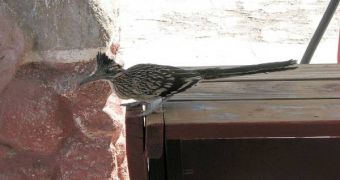While roadrunners are a fairly common appearance in the southwestern parts of North America, naturalists know surprisingly little about them, mostly because the creatures are very difficult to capture. In a new scientific paper, accompanying a four-year study of wild roadrunners, scientists finally shed some light on the habitat of the elusive bird. The team managed to tag about 50 such animals with radio transmitters, and then observe them in their natural environment indirectly.
“As a predatory bird, they're pretty wary, and they appear somewhat intelligent in terms of being able to avoid a trap, so they're not easy to capture for study,” says researcher and wildlife ecologist Dean Ransom from Texas AgriLife Research. The new study could offer some precious insight into how the area is affected by climate change and global warming, the scientist believes, and could help authorities devise plans to limit the effects of the plight.
The biggest challenge the team had in capturing the roadrunners was to lure them into nets. They tried playing songs of mating birds to attract would-be competitors but, while the animals indeed came to look for rivals, they did not enter the nets. “We hit upon using a trap for birds of prey, a leg noose baited with a live mouse,” Ransom states. Each of the 50 trapped birds was then outfitted with a radio transmitter and released back into the wild, while experts kept an eye on them from a distance over the last four years, LiveScience informs.
Among the most interesting finds that were made possible with this study was discovering how these animals live. Parents are apparently monogamous, meaning that they select and keep the same partner over all mating seasons. Nest cameras have revealed that they feed their young with horned lizards, primarily, but also with snakes, spiders, mice, grasshoppers and so on. In some instances, if many eggs were found in the same nest, the older siblings were discovered to be eating their younger brothers. It was also discovered that their range is actually a lot larger than first estimated.
“These are just birds that are 350 grams or so (roughly three-quarters of a pound), yet they're able to use an area of 100 hectares or 250 acres. That's quite a feat. I wouldn't think twice about that for a wild turkey, a 13-lbs. big, long-legged heavy bird, but for a roadrunner that seems extreme and was really surprising to me,” Ransom adds. “While roadrunners so far are not in trouble, a lot of birds inhabiting the same areas seem to be. So because they have such large spatial requirements, they might be able to serve as an indicator species of something going wrong in an environment, like a canary in a coal mine. Learning more about roadrunners could therefore shed light on the human footprint on areas.”
The researchers also revealed that odd behaviors have been identified in the birds. “At one camera of a nest, we saw an untagged bird sitting at the edge of a nest, and the only way a mated pair might let that happen – roadrunners are territorial birds – is if the third bird is related. So there might be a helpers-at-the-nest behavior going on there. We'd like to know more about that,” the expert concludes.

 14 DAY TRIAL //
14 DAY TRIAL //